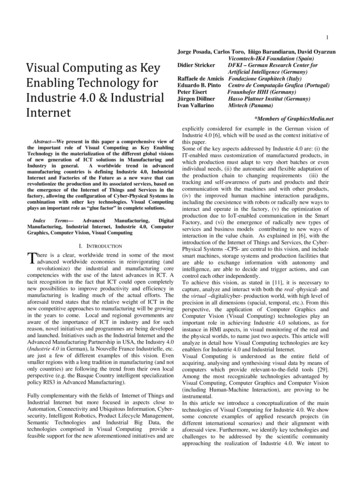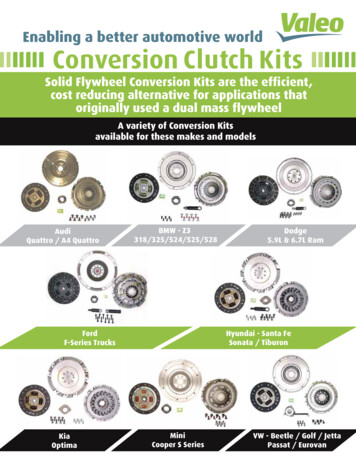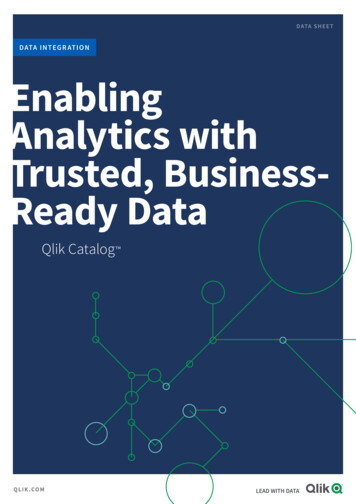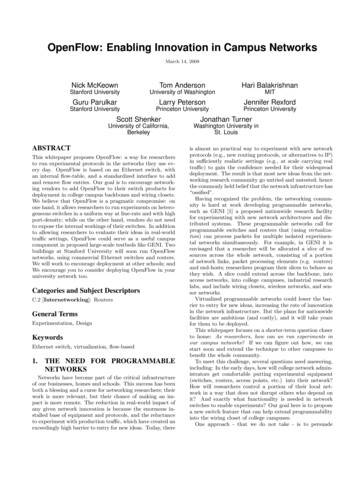
Transcription
1Visual Computing as KeyEnabling Technology forIndustrie 4.0 & IndustrialInternet Abstract—We present in this paper a comprehensive view ofthe important role of Visual Computing as Key EnablingTechnology in the materialization of the different global visionsof new generation of ICT solutions in Manufacturing andIndustry in general.A worldwide trend in advancedmanufacturing countries is defining Industrie 4.0, IndustrialInternet and Factories of the Future as a new wave that canrevolutionize the production and its associated services, based onthe emergence of the Internet of Things and Services in thefactory, allowing the configuration of Cyber-Physical Systems incombination with other key technologies. Visual Computingplays an important role as “glue factor” in complete alManufacturing, Industrial Internet, Industrie 4.0, ComputerGraphics, Computer Vision, Visual ComputingI. INTRODUCTIONThere is a clear, worldwide trend in some of the mostadvanced worldwide economies in reinvigorating (andrevolutionize) the industrial and manufacturing corecompetencies with the use of the latest advances in ICT. Atacit recognition in the fact that ICT could open completelynew possibilities to improve productivity and efficiency inmanufacturing is leading much of the actual efforts. Theaforesaid trend states that the relative weight of ICT in thenew competitive approaches to manufacturing will be growingin the years to come. Local and regional governments areaware of the importance of ICT in industry and for suchreason, novel initiatives and programmes are being developedand launched. Initiatives such as the Industrial Internet and theAdvanced Manufacturing Partnership in USA, the Industry 4.0(Industrie 4.0 in German), la Nouvelle France Industrielle, etc.are just a few of different examples of this vision. Evensmaller regions with a long tradition in manufacturing (and notonly countries) are following the trend from their own localperspective (e.g. the Basque Country intelligent specializationpolicy RIS3 in Advanced Manufacturing).Fully complementary with the fields of Internet of Things andIndustrial Internet but more focused in aspects close toAutomation, Connectivity and Ubiquitous Information, Cybersecurity, Intelligent Robotics, Product Lifecycle Management,Semantic Technologies and Industrial Big Data, thetechnologies comprised in Visual Computing provide afeasible support for the new aforementioned initiatives and areJorge Posada, Carlos Toro, Iñigo Barandiaran, David OyarzunVicomtech-IK4 Foundation (Spain)Didier StrickerDFKI – German Research Center forArtificial Intelligence (Germany)Raffaele de Amicis Fondazione Graphitech (Italy)Eduardo B. Pinto Centro de Computação Grafica (Portugal)Peter EisertFraunhofer HHI (Germany)Jürgen DöllnerHasso Plattner Institut (Germany)Ivan VallarinoMivtech (Panama)*Members of GraphicsMedia.netexplicitly considered for example in the German vision ofIndustrie 4.0 [6], which will be used as the context initiative ofthis paper.Some of the key aspects addressed by Industrie 4.0 are: (i) theIT-enabled mass customization of manufactured products, inwhich production must adapt to very short batches or evenindividual needs, (ii) the automatic and flexible adaptation ofthe production chain to changing requirements (iii) thetracking and self-awareness of parts and products and theircommunication with the machines and with other products,(iv) the improved human machine interaction paradigms,including the coexistence with robots or radically new ways tointeract and operate in the factory, (v) the optimization ofproduction due to IoT-enabled communication in the SmartFactory, and (vi) the emergence of radically new types ofservices and business models contributing to new ways ofinteraction in the value chain. As explained in [6], with theintroduction of the Internet of Things and Services, the CyberPhysical Systems –CPS- are central to this vision, and includesmart machines, storage systems and production facilities thatare able to exchange information with autonomy andintelligence, are able to decide and trigger actions, and cancontrol each other independently.To achieve this vision, as stated in [11], it is necessary tocapture, analyze and interact with both the real -physical- andthe virtual –digital/cyber- production world, with high level ofprecision in all dimensions (spacial, temporal, etc.). From thisperspective, the application of Computer Graphics andComputer Vision (Visual Computing) technologies play animportant role in achieving Industrie 4.0 solutions, as forinstance in HMI aspects, in visual monitoring of the real andthe physical worlds, to name just two aspects. This article willanalyze in detail how Visual Computing technologies are keyenablers for Industrie 4.0 and Industrial Internet.Visual Computing is understood as the entire field ofacquiring, analysing and synthesising visual data by means ofcomputers which provide relevant-to-the-field tools [29].Among the most recognizable technologies advantaged byVisual Computing, Computer Graphics and Computer Vision(including Human-Machine Interaction), are proving to beinstrumental.In this article we introduce a conceptualization of the maintechnologies of Visual Computing for Industrie 4.0. We showsome concrete examples of applied research projects (indifferent international scenarios) and their alignment withaforesaid view. Furthermore, we identify key technologies andchallenges to be addressed by the scientific communityapproaching the realization of Industrie 4.0. We intent to
2provide an integrated view and an international perspective ofthe current trends and challenges of Visual Computing forIndustrie 4.0. Our discourse is based on the common view andaggregated experiences of relevant applied research centres inEurope and America).We argue that Visual Computing could play and importantrole in the development of Industrial Internet and Industrie 4.0paradigms.This paper is structured as follows: in section II we present anillustration of concepts focusing in the topics of IndustrialInternet and Industrie 4.0 and showing the need of VisualComputing technologies. In section III we illustrate therelevance of Visual Computing as Key Enabling Technologywith an arguably central role in both visions, detailing themost relevant technologies for the related industrial priorities.Section IV proposes specific application and researchchallenges in the field, and lastly, in section V we show someexamples of projects where Visual Computing plays a relevantrole for Industrie 4.0.II. INDUSTRIE 4.0 AND INDUSTRIAL INTERNET AS GLOBALTRENDS WITH VISUAL COMPUTING NEEDSAdvanced Manufacturing is defined as the kind ofmanufacturing that entails rapid transfer of new knowledgeinto industrial processes and products [15]. It is widelyaccepted that ICT technologies are Key EnablingTechnologies to accelerate and improve productivity inmanufacturing. The deployment of ICT in the late 60s intoproduction was actually an Industrial Revolution. Thecompetitive factories of today cannot be conceived withouttoday s Industrial Automation pyramid (including PLC, MES,ERP and other key technologies) in production, or without theProduct Lifecycle Management supported by advancedCAD/CAM/CAE tools, just to mention a few evident cases.Recent developments in ICT are arguably openingrevolutionary possibilities for manufacturing and production,being the most important one the implementation of the latestinternet-related technologies in the industry. Due to severaltechnical, market and cultural reasons, industry isparadoxically one of the last niches to be conquered by thepervasive and ubiquitous developments associated with theInternet of Things and Services.In the USA, the so called “Industrial Internet - the ThirdWave” –term coined by General Electric in their visionarypaper [1] already widely accepted in many Americanacademic organizations such as NSF I/URCC Center forIntelligence Maintenance Systems (IMS) and other relevantindustrial actors, has a strong focus on a higher degree ofintelligence with the power of advanced computing, analytics,low-cost sensing and new levels of connectivity permitted bythe Internet [23]. Three elements characterize this vision:(i) intelligent machines,(ii) advanced analytics, and(iii) people at work.In Figure 1 the data loop of Industrial Internet points out veryrelevant aspects for which Visual Computing could be a KeyEnabling Technology, such as remote and centralized datavisualization, or big data analytics.Figure 1. Industrial Internet data loop (General Electric) [1]On the other side, the strategic initiative Industrie 4.0 (whoseleitmotiv is as ambitious as “Securing the future of GermanManufacturing Industry”) [6] has created not only a Germanwide but an international landmark in terms of setting thevision, technological opportunities and scientific challenges,related with the entrance of the new generation of ICTtechnologies, including the Internet of Things and Servicesand the Cyber-Physical Systems (or CPS) [10,16], in industrialproduction systems. The basic idea is that we are facing afourth industrial revolution (see Figure 2), with disruptiveapplications of new generations of ICT in manufacturing.Interestingly enough, the CPS concept was actually coined byUS in 2006-2008 by Lee et al. [7]. This concept has beenreadily adopted in Europe by Germany in the Industrie 4.0initiative and later by the European Union in their H2020research framework program [5]. CPS refers to theconvergence of the physical world and the digital world(cyberspace). When applied to production, CPS is specializedin CPPS or Cyber-Physical Production Systems. Evenconsidering that there is some criticism regarding certainvagueness in the term and sometimes excessive marketing [4],it is now widely accepted that the vision and the relatedtechnologies of Industrie 4.0 have set already a real impact incurrent and future industrial manufacturing systems.Reputedindependent studies [22] show that the potential of Industry4.0 is already on its way, and that its international scope isclear, especially for Europe. This study shows specificexamples of European companies (such a Trumpf –smartsocial machines-, Siemens –customized knee implants-, Boschand many others in Germany, but also Rolls-Royce -3Dprinting of jet engine components- in UK, and Dassault –cloudbased collaborative 3D CAD- in France, for instance) arepioneering this trendIn both USA and European visions a strong industrialcommitment with long term associations is backed up byresearch institutions: The Industrial Internet Consortium wasconstituted in 2014 and the Industrie 4.0 Plattform in 2013.
3factor” providing a cohesion element in many applicationsrelated with Industrie 4.0 and Industrial Internet. Although inseveral scenarios of Industry 4.0 there is no specific role forVisual Computing (as for instance in pure IoT connectivityapplications between machines and parts), in many relevantcases its role as facilitator and integrator of other technologiesenhances sensibly the final application. As a relevant example,Visual Analytics solutions can link industrial Big Dataprocessing & mining, with Semantic Technologies andProduct Lifecycle Management technologies (each technologyseparately would have a more limited impact).III. VISUAL COMPUTING AS KEY ENABLING TECHNOLOGYFOR THE NEXT INDUSTRIAL REVOLUTIONFigure 2. Industrie 4.0–The 4th Industrial Revolution with CPS [6]In Figure 3, a conceptualization of Industrie 4.0 and impliedinteraction technologies by a leading machine tool producer(Trumpf) [9] is shown. The coexistence and mutual interactionof the physical world and the virtual (cyber) world, with theuse of emerging ICT, opens possibilities such as:(i) the concept of social machines following paradigms ofInternet connectivity and Social Networks,(ii) the seamless interconnection of global facilities,(iii) the advantaging of augmented operators with extendedperception and action possibilities and(iv) last but not least, the use of Smart Products able to knowand update their status providing services in a virtualproduction context.As it will be shown in the next section, the detailedtechnological concepts behind Industrie 4.0 are somewhatlacking of cohesion. Diverse technologies such as Big Data,Advanced HMI, 3D Models and Simulations, CloudComputing, Cyber-Physical Systems, Internet of Things andServices, Machine to Machine (M2M), and Smartization [8]can be applied in Industrie 4.0 solutions. Isolated, they seem tohave no evident relation but when used together in anindustrial application context their added value brings newpossibilities.Figure 3. Interaction possibilities in a Smart Factory scenario [9]We argue that Visual Computing technologies are animportant Key Enabling Technology that could act as a “glueOne of the most successful application areas for ComputerGraphics has been industry and manufacturing. To point out avery relevant example, the whole field of 3D CAD/CAM/CAEis a very direct consequence of the key enabling capability ofComputer Graphics in the right industrial moment. 3D CADresearch that started in the late 60 s has been decisive for thecompetitiveness of many industrial sectors, conspicuously theautomotive, aeronautic, industrial plants and machine-toolsectors. In the case of Computer Vision, the industrial sectorhas also a great importance, especially when applied to qualitycontrol and inspection (Machine Vision) of manufacturedproducts, and more recently to robotic control, to name tworelevant fields. Almost every manufacturing industry has suchsystems integrated. These evident examples complemented bymany others, showing how Visual Computing technologieshave a very strong position in modern digital manufacturing.We consider that Visual Computing will be also a KeyEnabling Technology in the new generation of IndustrialInternet and Industrie 4.0, al
the important role of Visual Computing as Key Enabling Technology in the materialization of the different global visions of new generation of ICT solutions in Manufacturing and Industry in general. A worldwide trend in advanced manufacturing countries is defining Industrie 4.0, Industrial Internet and Factories of the Future as a new wave that can revolutionize the production and its .











